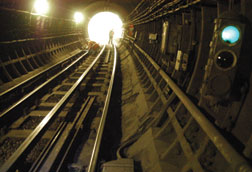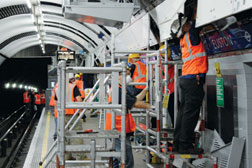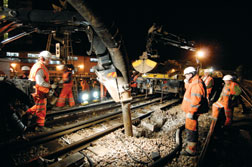 Tube Lines |
Procuring contracts to finance, maintain, operate and upgrade infrastructure of London’s vast subway system was a $900-million process even before a spade of concrete was mixed. Lawyers, engineers and managers honed the multi-billion dollar public-private partnerships with meticulous care. Yet, with the 30-year project still ramping up, one consortium is bankrupt while the other reports profits ahead of projections.
By hiring external contractors, the Tube Lines consortium nimbly cleared numerous hurdles arising from modernizing a third of one of the world’s oldest and biggest metros the London Underground. On the rest of the system, alleged grey areas in scope setting tested the self-performing strategy of the Metronet Rail team to destruction.
Metronet has been controlled by a court-appointed administrator since July after hugely overrunning on budgets. Late last month, the city’s Transport for London (TfL) announced its bid for Metronet, aiming to restructure the companies to continue their work in the long-term. A sale is expected early next year. Chances of Metronet’s five consortium members recovering any of the $700 million they invested in the project’s financing are virtually nil, concedes a senior source, asking not to be named.
Metronet partners continue to work on the project, but are now reporting to the administrator. Metronet is owned by design firm W.S. Atkins, contractor Balfour Beatty Group, utilities EDF Energy and Thames Water and train manufacturer Bombardier Transportation.
In two contracts signed in April 2003, Metronet was responsible for financing, maintaining and upgrading stations, tracks and trains on two-thirds of the system, which is 408-km long with 275 stations. Metronet’s work in the busiest first 7.5 years was budgeted at about $14 billion.
 |
 Renewing old subway tracks and upgrading cables presented risk
|
In that time, Tube Lines is expected to spend about $9 billion on the Underground’s remaining third under one contract, started at the end of 2002. Tube Lines’s capital investment of about $4 billion is spread roughly equally between fixed infrastructure and trains. It has about 1,250 staff working on capital projects, with maintenance crews raising the total to around 3,500.
With roughly 70% of the first 7.5 year’s budget spent, Tube Lines is “slightly ahead of program,” says Finance Director Steve Hurrell. “Tube Lines did a tremendous job in planning...executing their plan and following through,” says Peter Zuk, Chief Programme Officer with the owner, London Underground Ltd. (LUL).
Preparing to privatize maintenance and enhancement of the system, some of it over 110 years old, was laborious. LUL alone paid about $60 million to attorneys, five times more than on external engineers. Total bidding costs exceeded $900 million. LUL has been paying fees to its PPP contractors totalling about $2.2 billion a year.
Because of uncertainty over future requirements, the contracts are divided by review periods every 7.5 years. They allow LUL to refine the project scope and costs.
 |
| HURRELL |
“When the contracts were signed, what Metronet proposed was very standard in the project finance world...that was seen as a positive thing,” says Mike Adams, president of Bechtel Civil, San Francisco, who helped formulate Tube Lines’s bid. Bechtel owns a third of Tube Lines while Amey plc., has the rest.
By having construction contracts tied up from the start, “the banks have greater certainty,” reducing borrowing costs, says the Metronet source. And getting contractors involved early was becoming more common. Tube Lines’s approach was “rather old fashioned,” he adds.
Explaining why Tube Lines bucked the trend, Hurrell says: “The nature of this PPP is quite different....Under normal circumstance, you have...a construction phase...
As well as being equal consortium shareholders, four of Metronet’s partners handled fixed infrastructure work directly. Atkins, Balfour Beatty and the two utilities did station and civil work through an alliance. Atkins, for example, at one time had 500 staffers dedicated to the contracts.
 Related Links:
Related Links: 
Post a comment to this article
Report Abusive Comment